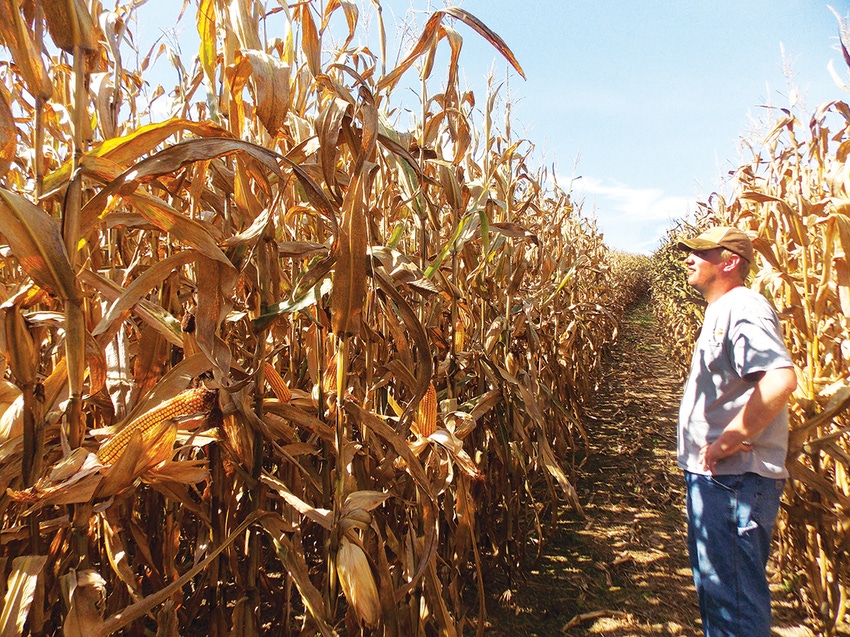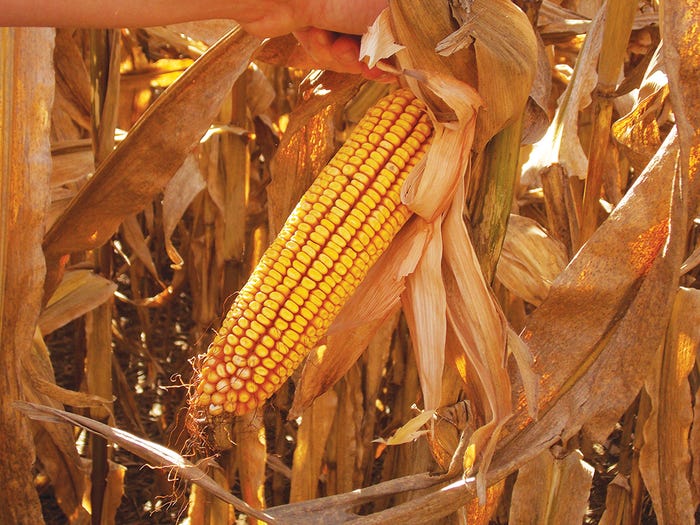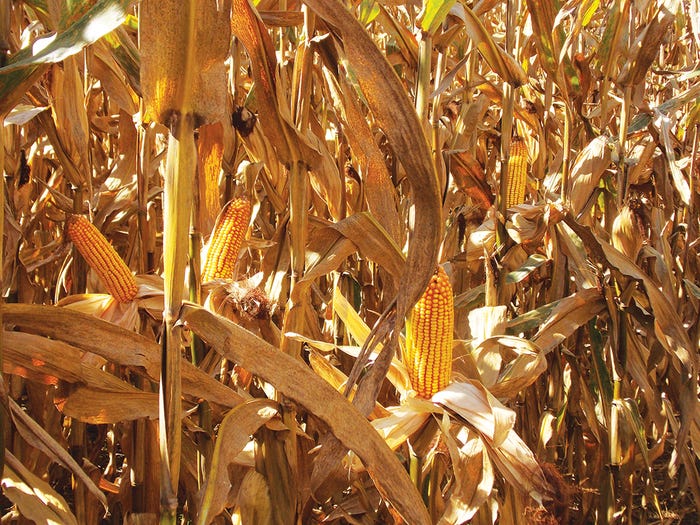December 5, 2017

All season long, Kyle Dixon had been looking forward to the day when he could see how new DeKalb Disease Shield corn stacked up against one of his regular hybrids in a trial on his farm near Fulton, Ky.
But when he made the first round in the field containing the two hybrids, his combine broke down. To top it all off, he was also expecting a visitor who wanted to see how the new DEKALB Disease Shield hybrid fared.
 The leaves from the non-Disease Shield hybrid in Kyle Dixon’s right hand are showing a much higher level of southern rust than the Disease Shield leaves in his left hand in this photo taken Aug. 25.
The leaves from the non-Disease Shield hybrid in Kyle Dixon’s right hand are showing a much higher level of southern rust than the Disease Shield leaves in his left hand in this photo taken Aug. 25.

While he waited on a mechanic to bring the parts for the combine, Kyle, who farms with his father, Kirk Dixon, and brother, Kris Dixon, took the visitor to the two fields where he grew the DeKalb DKC64-35 brand hybrid containing the Disease Shield package and the DeKalb DKC65-20 brand hybrid next to each other.
“See how the stalks are still green in the Disease Shield corn,” he says. “In the other hybrid, the plants are deteriorated. There’s a little bit of green on the stalks, but not as much. This corn is finished. I can also see a difference in the ears.”
The outcome of the trial is important to the Dixons because they grow continuous no-till corn — two years of corn followed by a year of soybeans. They are strong proponents of no-till — Kirk’s father planted the first no-till field on the farm in 1971, and many of their fields have been in no-till for three decades or more.
NARROWER ROW SPACINGS
“Some of our neighbors have tried no-till for two or three years,” Kyle says, “and then something happens — the fields get rutted or they have weed problems — and they go back to conventional tillage. You don’t see the benefits of no-till until you’ve done it for several years.”
The Dixons also plant corn in 20 inch rows to help increase yield. That means the plants are generally taller, and there’s less air flow between the more closely-spaced plants, which creates nearly ideal conditions for disease pathogens to be splashed up on plants from no-till residue, or blown into the field from southerly winds. They spray a fungicide, Stratego YLD, early in the season, but it’s only effective for 28-30 days.
“It’s too expensive if we have to spray again,” says Kyle. “When the fungicide played out, that’s when we really saw the difference in the two hybrids. We need protection in the plant that will take us all the way to harvest.”
The Dixons have seen some southern rust this season — it’s typically windblown — but they have to deal with gray leaf spot every year.
HIGHER YIELDS, SAME ACRES

 Kyle Dixon believes he can tell a difference between the ears of the DeKalb Disease Shield-protected corn on the top and the non-Disease Shield corn on bottom.
Kyle Dixon believes he can tell a difference between the ears of the DeKalb Disease Shield-protected corn on the top and the non-Disease Shield corn on bottom.

The Dixons grow about 1,300 acres of corn and 700 acres of soybeans, most behind wheat. Like more and more farmers these days, they do almost all of the work themselves, with some help from Kyle’s son, Kinzie, on the grain cart.
Planting wheat beans also helps them get the best use of their equipment and labor, because their soybeans usually aren’t ready for harvest until after corn is out of the field. They harvest most of the corn at 24 percent to 25 percent moisture and dry it to 15 percent or 15.5 percent, depending on whether it’s going to one of the several chicken operations that can be found in their region, or to a grain elevator, where it’s likely destined for export.
They also plant rye as a cover between the two corn crops to improve soil tilth and provide a cover on the soil during winter months. They typically plant the rye following corn harvest. “This soil is highly erodible,” says Kirk Dixon. “We have grades of 10 percent to 12 percent, but the soil itself washes, so we do everything we can to protect it and keep it where it’s supposed to be.”
In 1960, Kirk’s father bought the original 60 acre block of land where they currently farm, and they’ve gradually expanded to the current 2,000 acres.
STARTED IN HIGH SCHOOL
“We don’t care about getting much bigger,” says Kyle. “I’m not as interested in farming more land as I am growing more corn per acre.”
Kyle, who’s 35, began farming with his father when he was a senior in high school. “I would go to class until 9:30 in the morning, and then come home and put in a full day at the farm. It’s the only life I’ve ever known.”
Although no-till may require them to take extra steps in dealing with diseases, neither Dixon is ready to end the practice. The farm went 28 days without a rain in 2017, and while some of their fields are irrigated with center pivots, Kyle believes no-till helped make a difference.
“If it wasn’t for no-till, I think our yields could have been much lower,” he says, pointing to wheat residue left from last year in the no-till corn they were preparing to harvest this fall. “The residue helps preserve the moisture we have.”
Temperatures were also cooler. “We only had five days above 95 degrees,” Kyle says. “If we’d had normal temperatures, our yields could have been much lower.”
A STRIKING DIFFERENCE
The Dixons don’t discuss yields, but Kyle is hopeful the Disease Shield hybrid will improve their yields for 2017. “I think the leaves I pulled from the different hybrids show what kind of protection we can get from gray leaf spot most years, and from southern rust when conditions are favorable.” (Disease Shield also provides protection from Goss’ wilt, northern corn leaf blight, and anthracnose stalk rot.)
 The corn in the DeKalb Disease Shield trial on the Dixon Farm appeared to be ready for harvest Sept. 29.
The corn in the DeKalb Disease Shield trial on the Dixon Farm appeared to be ready for harvest Sept. 29.

One of the things Kyle has noticed is that ears of the non-Disease Shield corn had mostly turned over and were pointing down, while ears of the Disease Shield hybrid, which was planted on the same day, mostly remained erect. “To me, the quality of the Disease Shield ears also looked much better than the non-Disease Shield. And the Disease Shield corn was just greener than the non-Disease Shield. The latter was almost a point drier than the Disease Shield when I checked it the other day.”
After Kyle harvested the fields, he says the Disease Shield performed as advertised. “We had a yield increase that was about what they said it would be.”
In 2016, prior to commercialization, DeKalb Disease Shield achieved an average yield advantage of 12.1 bushels per acre in more than 1,400 trial plot comparisons with competitor corn products across the U.S., according to Monsanto. Average yield loss varies by disease, but can reach up to 18 bushels per acre. Other benefits included better standability and improved harvestability, according to the company.
�“Since it turned out like they said it would, in 2018 I’ll plant at least as much of it as we had this year (about 400 acres),” he says.
As the visitor prepared to leave, Kyle was still waiting to hear about the status of the part for their combine. Rather than waiting it out, he climbed into a truck and began driving a load of wheat to the elevator.
To read more about the product, visit www.DEKALB.com/DiseaseShield.
About the Author(s)
You May Also Like






